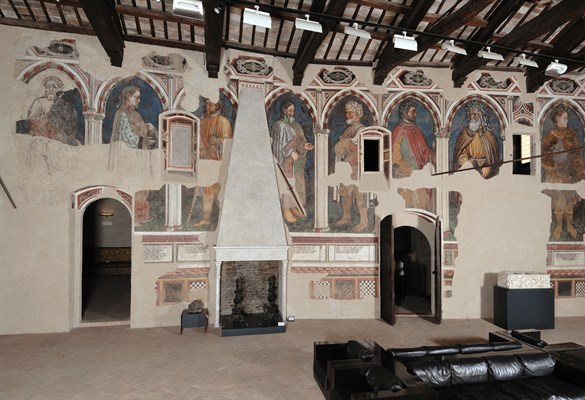Gli ambienti monumentali affrescati si trovano al secondo piano del Palazzo. In cima alla scala si trova un ampio vano, la Sala di Sisto IV, dal nome del Pontefice che nel 1475 fece rifare il soffitto ligneo su cui compare il suo stemma. È decorata da affreschi con motivi ornamentali e figurati della fine del Quattrocento a metà del Cinquecento, ampiamente restaurati nel 1930. Sul lato opposto la Loggia di Romolo e Remo sulla vita dei leggendari fondatori di Roma ai quali, i Trinci, volevano idealmente ricollegarsi. La vicina Cappella è ricoperta di affreschi di Ottaviano Nelli datati al 1424. Dalla Loggia si accede alla Sala delle Arti Liberali e dei Pianeti e al vicino Corridoio, in realtà "ponte sospeso", che collegava il Palazzo con la Cattedrale. Proseguendo si accede alla Sala degli Imperatori o dei Giganti, in cui si ammirano quindici delle venti originarie figure monumentali di grandi personaggi della storia romana. Il ciclo afferescato con tematiche laiche dopo il ritrovamento del "Taccuinio Coltellini" è attribuito a Gentile da Fabriano e collaboratori e datato 1411-1412.
THE FRESCOS OF THE PALACE
The palace is decorated with wonderful late gothic frescos realized by
Gentile da Fabriano and his team. The frescoes were realized between
1411-1412 and they are placed on the nobel floor. We can admire frescos about Romulus and Remus in the Loggia, the cycle of the “Age of Man” in the corridor connected with the cathedral, the series of Emperors or Giants,in the homonymous room, representing characters taken from the ancient history, especially the Roman one. In the room used as a studium, there are the liberal arts and the planets. The palatine chapel with the refined and elegant composition of the histories of the Virgin Mary, was realised by Ottaviano Nelly from Gubbio as we can see from his signature and the date of the 24 February 1424.
LES FRESQUES DU PALAIS
Le Palais est décoré avec de magnifiques fresques gothiques tardives, œuvre de Gentile da Fabriano et des ses collaborateurs, réalisés entre 1411 - 1412, qui se trouvent à l'étage noble. On peut admirer des fresques représentant Romulus et Rémus dans la Loggia, le cycle de l’âge de l’homme dans le couloir reliant le palais à la cathédrale, la Salle des Empereurs ou des Géants, avec des personnages de l’histoire ancienne, en particulier l’époque romaine. Dans la salle utilisée comme Studium, on trouve des fresques des arts libéraux et des planètes. La chapelle palatine avec les Histoires de la Vierge est réalisée par Ottaviano Nelli de Gubbio. On peut voir sa signature ainsi que la date du 25 février 1424.

